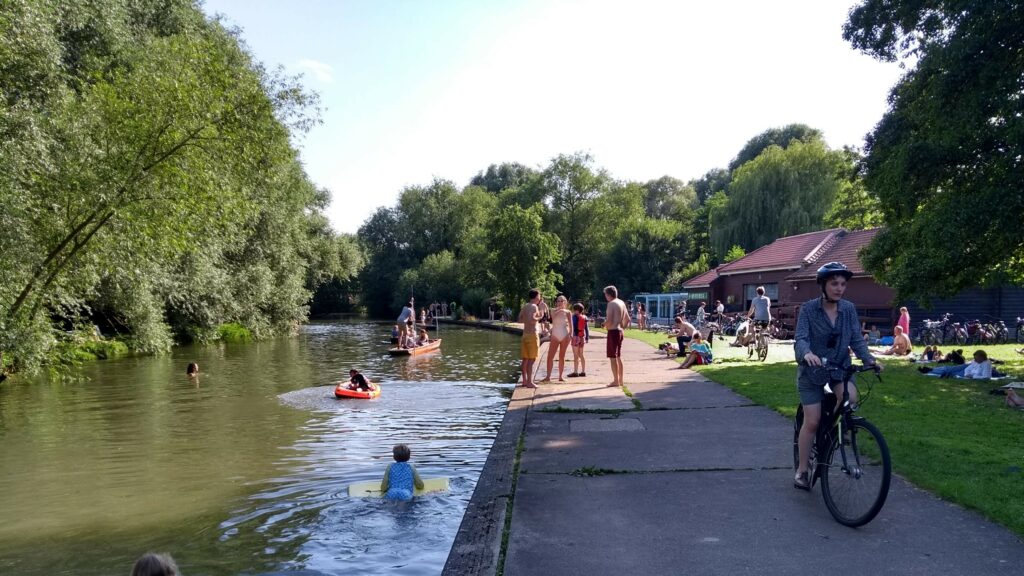
This page introduces our water quality testing work. We want to understand the sources of the poor water quality in our local rivers so we can get the pollution stopped.
You can see the test results from our monitoring on the Cam and its tributories here and the weekly test results from the monitoring Anglian Water did for us Sept 2022- Oct 2023 here. Now that we’ve achieved Bathing Water Designation, you can see the Environment Agency’s test results here
Our advice to swimmers is here and our reports here
CVF’s two main concerns are the health risk from bacteria and viruses from human and animal faecal sources, and secondly the detrimental effects of eutrophication. Eutrophication is the process by which rivers become excessively enriched with minerals and nutrients such as nitrate and phosphate. This has a significant detrimental effect on the ecological balance of the river and increases the growth of algae and invasive plants such as Floating Pennywort. Excessive plant growth reduces biodiversity, sensitive plants suited to low nutrients decline, and plant decomposition by bacteria results in reduced oxygen levels which harms invertebrates, fish and other wildlife.
We all want Chalk streams – and the Cam is one in its upper reaches – to be crystal clear and unpolluted. We all want the Cam to become cleaner and less eutrophic. This needs both less pollution, and clean water to dilute and wash away contamination. However, in summer the water levels in our aquifier are now so low that the “natural” flow rate reduces significantly, which increases the concentrations of organisms arising from sewage effluent, of soluble nutrients and of other pollutants. In an attempt to maintain river flows and reduce the concentrations to permitted levels, water is pumped out of the aquifier into the rivers.
This circular process of abstracting scarce water from the aquifer and then augmenting the Chalk streams is ecological madness: we need to reduce the pollution at source.
To try to find out where the pollution is coming from locally, we are monitoring water quality. To explore faecal contamination, we are taking water samples at strategic points and having them analysed for E. coli and intestinal enterococci bacteria, which is well recognised as a reliable indicator of human faeces (poo) contaminating the water. We are also sampling for phosphate and nitrate.
You can see the test results from our monitoring on the Cam and its tributories here and the weekly test results from the monitoring Anglian Water did for us Sept 2022- Oct 2023 here. Now that we’ve achieved Bathing Water Designation, you can see the Environment Agency’s test results here
Advice to swimmers and river users

The official current standards for Designated Bathing Waters in England are based on multiple bacterial counts by the Environment Agency over a summer season which are used to give the waters a classification status for the following season. lots of people swim in the Cam, which is why we applied for ‘Designated Bathing Water’ status. This was achieved in May 2024, so the Environment Agency is now testing it, and hence there is official recognition of the poor water quality. The Environment Agency is investigating the causes of the poor water quality and there is an obligation to clean up .
Although we expect that swimmers and other river users will find the results of great interest, however please note that our results should NOT be used as guidance as to where or when it is safe to swim.
There may be nasty human pathogenic organisms in the river that our indicator bacteria counts don’t reveal, and we know that changes in the weather and rainfall will influence the results, sometimes suddenly and unpredictatably. In addition, in times of high rainfall, some of the sewage treatment works above Cambridge occasionally discharge untreated sewage mixed with storm water (combined sewage overflows – CSOs).
Our results suggest that, of the swimming spots we have monitored, the pollution is worst at Byron’s pool, which is the closest to Haslingfield Sewage works. In general the water quality is slightly better downstream, eg at Newnham Riverbank Club, Sheeps Green. This is more noticeable in the summer because sunlight helps neutralise the bacteria.
Our general advice is to
- Use your own judgement about when and where its safe for you to swim.
- Never drink water from the Cam (always keep your mouth shut when swimming)
- Dry off by vigorous rubbing with a towel.
- Shower as soon as possible after leaving the water, particularly if you’ve got muddy.
- Don’t swim just downstream of a sewage treatment works.
- Consider not swimming in the days after a period of heavy rainfall.
Don’t forget that some faecal presence in the river is natural.
Do join us.
To continue this work and help clean up the Cam, we very much welcome volunteers to help collect samples, and contributions towards the costs of the analysis.
We are grateful to our sponsors and supporters for funding this work
2022 sponsors and supporters

Newnham Riverbank Club.
Other anonymous donors
2021 sponsors and supporters


